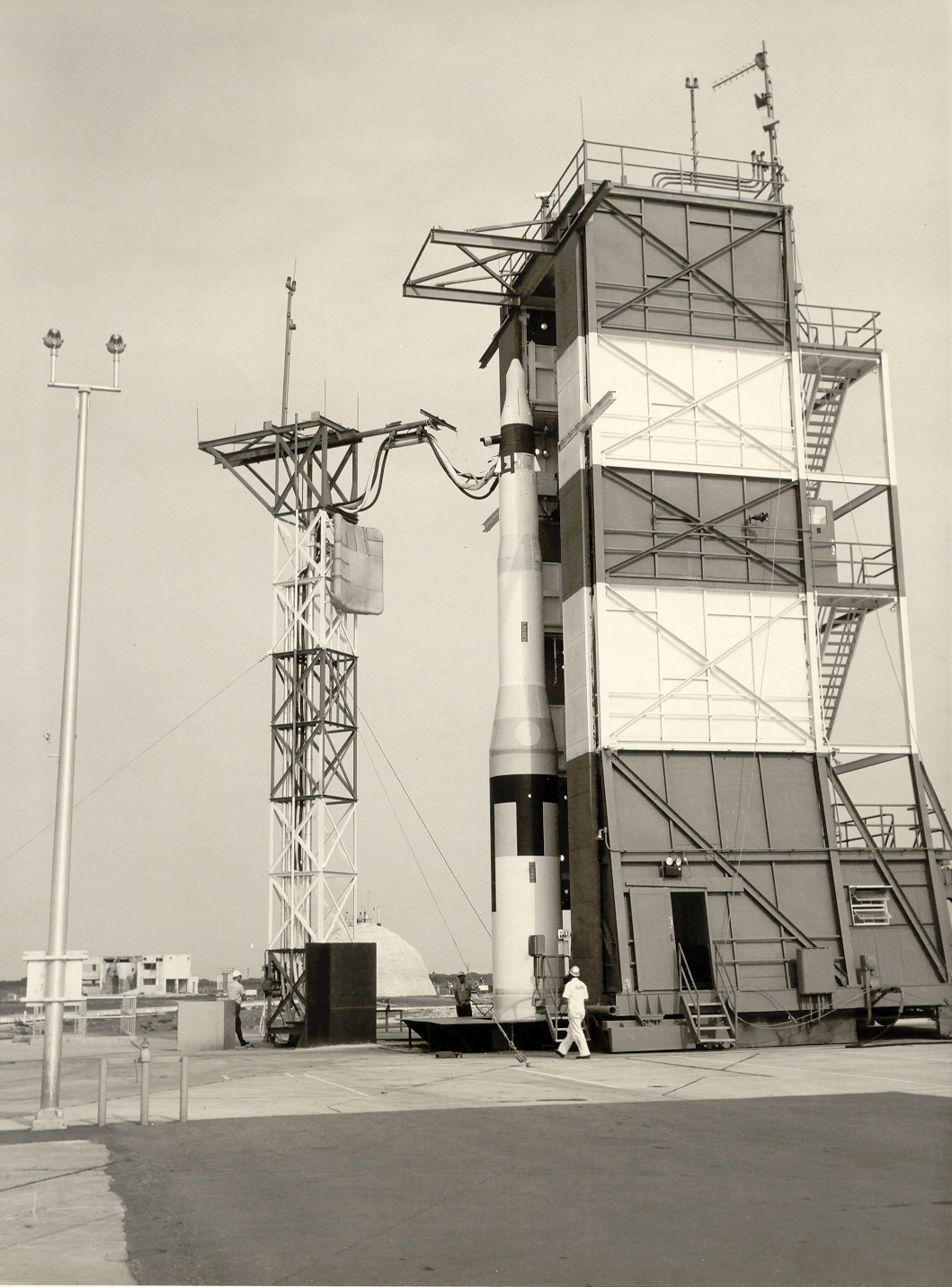|
LGM-118 Peacekeeper
The LGM-118 Peacekeeper, originally known as the MX for "Missile, Experimental", was a MIRV-capable intercontinental ballistic missile (ICBM) produced and deployed by the United States from 1985 to 2005. The missile could carry up to twelve Mark 21 reentry vehicles (although treaties limited its actual payload to 10), each armed with a 300-kiloton W87 warhead. Initial plans called for building and deploying 100 MX ICBMs, but budgetary concerns eliminated the final procurement; only 50 entered service. Disarmament treaties signed after the Peacekeeper's development led to its withdrawal from service in 2005. Studies on the underlying concept started in the 1960s. The idea was to allow the U.S. to absorb a sneak attack by the USSR with enough warheads surviving to attack the remaining Soviet missile silos. To do so, the missiles had to be highly accurate, be based in such a way that enough would survive a nuclear attack, carry a large number of warheads so the survivors would still ... [...More Info...] [...Related Items...] OR: [Wikipedia] [Google] [Baidu] |
1st Strategic Aerospace Division
The 1st Strategic Aerospace Division (1st STRAD) is an inactive United States Air Force organization. Its last assignment was with Strategic Air Command, assigned to Fifteenth Air Force, being stationed at Vandenberg Air Force Base, California. It was inactivated on 1 September 1991. The division directed and supervised heavy bombardment (1943–1945) and fighter (1944–1945) operations during World War II within the Eighth Air Force in the European Theater. Replacing the Eighth Air Force in Okinawa in June 1946, the division directed fighter reconnaissance and bomber organizations, and provided air defense for the Ryukyu Islands, Japan until December 1948. From 1954 to 1955, the division served as a holding unit at Westover Air Force Base, Massachusetts, for personnel of Eighth Air Force, who moved to the base as part of a transfer of Eighth's headquarters from Carswell Air Force Base, Texas. Activated again under the Air Research and Development Command in April 1957, it was ... [...More Info...] [...Related Items...] OR: [Wikipedia] [Google] [Baidu] |
Circular Error Probable
In the military science of ballistics, circular error probable (CEP) (also circular error probability or circle of equal probability) is a measure of a weapon system's precision. It is defined as the radius of a circle, centered on the mean, whose perimeter is expected to include the landing points of 50% of the rounds; said otherwise, it is the median error radius. That is, if a given munitions design has a CEP of 100 m, when 100 munitions are targeted at the same point, 50 will fall within a circle with a radius of 100 m around their average impact point. (The distance between the target point and the average impact point is referred to as bias.) There are associated concepts, such as the DRMS (distance root mean square), which is the square root of the average squared distance error, and R95, which is the radius of the circle where 95% of the values would fall in. The concept of CEP also plays a role when measuring the accuracy of a position obtained by a navig ... [...More Info...] [...Related Items...] OR: [Wikipedia] [Google] [Baidu] |
Anti-Ballistic Missile Treaty
The Anti-Ballistic Missile Treaty (ABM Treaty or ABMT) (1972–2002) was an arms control treaty between the United States and the Soviet Union on the limitation of the anti-ballistic missile (ABM) systems used in defending areas against ballistic missile-delivered nuclear weapons. It was intended to reduce pressures to build more nuclear weapons to maintain deterrence. Under the terms of the treaty, each party was limited to two ABM complexes, each of which was to be limited to 100 anti-ballistic missiles. Signed in 1972, it was in force for the next 30 years. In 1997, five years after the dissolution of the Soviet Union, four former Soviet republics agreed with the United States to succeed the USSR's role in the treaty. In June 2002 the United States withdrew from the treaty, leading to its termination, citing risks of nuclear blackmail. Background Throughout the late 1950s and into the 1960s, the United States and the Soviet Union had been developing missile systems with ... [...More Info...] [...Related Items...] OR: [Wikipedia] [Google] [Baidu] |
START II
START II (Strategic Arms Reduction Treaty) was a bilateral treaty between the United States and Russia on the Reduction and Limitation of Strategic Offensive Arms. It was signed by US President George H. W. Bush and Russian President Boris Yeltsin on 3 January 1993, banning the use of multiple independently targetable re-entry vehicles (MIRVs) on intercontinental ballistic missiles (ICBMs). Hence, it is often cited as the De-MIRV-ing Agreement. It was ratified by the US Senate on 26 January 1996 with a vote of 87–4. Russia ratified START II on 14 April 2000, making it conditional on preserving the ABM Treaty. When the US withdrew from the ABM Treaty on June 13, 2002, Russia withdrew from START II one day later. Thus, START II never entered into effect. Instead, SORT came into effect, which reduced the strategic warheads count per country to 1,700–2,200. Impact of MIRV ICBMs using MIRVs are considered destabilizing because they put a premium on a first strike. These m ... [...More Info...] [...Related Items...] OR: [Wikipedia] [Google] [Baidu] |
Initial Operational Capability
Initial operating capability or initial operational capability (IOC) is the state achieved when a capability is available in its minimum usefully deployable form. The term is often used in government or military procurement. The United States Department of Defense chooses to use the term ''initial operational capability'' when referring to IOC. For a U.S. Department of Defense military acquisition, IOC includes operating the training and maintaining parts of the overall system per DOTMLPF, and is defined as:"In general, attained when some units and/or organizations in the force structure scheduled to receive a system have received it and have the ability to employ and maintain it. The specifics for any particular system IOC are defined in that system’s Capability Development Document (CDD) and Capability Production Document (CPD)."The date at which IOC is achieved often defines the in-service date (ISD) for an associated system A system is a group of interacting or interr ... [...More Info...] [...Related Items...] OR: [Wikipedia] [Google] [Baidu] |
Vertical Launching System
A vertical launching system (VLS) is an advanced system for holding and firing missiles on mobile naval platforms, such as surface ships and submarines. Each vertical launch system consists of a number of ''cells'', which can hold one or more missiles ready for firing. Typically, each cell can hold a number of different types of missiles, allowing the ship flexibility to load the best set for any given mission. Further, when new missiles are developed, they are typically fitted to the existing vertical launch systems of that nation, allowing existing ships to use new types of missiles without expensive rework. When the command is given, the missile flies straight up far enough to clear the cell and the ship, then turns on to the desired course. A VLS allows surface combatants to have a greater number of weapons ready for firing at any given time compared to older launching systems such as the Mark 13 single-arm and Mark 26 twin-arm launchers, which were fed from behind by a ... [...More Info...] [...Related Items...] OR: [Wikipedia] [Google] [Baidu] |
LGM-30 Minuteman
The LGM-30 Minuteman is an American land-based intercontinental ballistic missile (ICBM) in service with the Air Force Global Strike Command. , the LGM-30G Minuteman III version is the only land-based ICBM in service in the United States and represents the land leg of the U.S. nuclear triad, along with the Trident submarine-launched ballistic missile (SLBM) and nuclear weapons carried by long-range strategic bombers. Development of the Minuteman began in the mid-1950s when basic research indicated that a solid-fuel rocket motor could stand ready to launch for long periods of time, in contrast to liquid-fueled rockets that required fueling before launch and so might be destroyed in a surprise attack. The missile was named for the colonial minutemen of the American Revolutionary War, who could be ready to fight on short notice. The Minuteman entered service in 1962 as a deterrence weapon that could hit Soviet cities with a second strike and countervalue counterattack if ... [...More Info...] [...Related Items...] OR: [Wikipedia] [Google] [Baidu] |
Ronald Reagan
Ronald Wilson Reagan ( ; February 6, 1911June 5, 2004) was an American politician, actor, and union leader who served as the 40th president of the United States from 1981 to 1989. He also served as the 33rd governor of California from 1967 to 1975, after having a career in entertainment. Reagan was born in Tampico, Illinois. He graduated from Eureka College in 1932 and began to work as a sports announcer in Iowa. In 1937, Reagan moved to California, where he found work as a film actor. From 1947 to 1952, Reagan served as the president of the Screen Actors Guild, working to root out alleged communist influence within it. In the 1950s, he moved to a career in television and became a spokesman for General Electric. From 1959 to 1960, he again served as the guild's president. In 1964, his speech "A Time for Choosing" earned him national attention as a new conservative figure. Building a network of supporters, Reagan was elected governor of California in 1966. During his go ... [...More Info...] [...Related Items...] OR: [Wikipedia] [Google] [Baidu] |
Jimmy Carter
James Earl Carter Jr. (born October 1, 1924) is an American politician who served as the 39th president of the United States from 1977 to 1981. A member of the Democratic Party, he previously served as the 76th governor of Georgia from 1971 to 1975 and as a Georgia state senator from 1963 to 1967. Since leaving office, Carter has remained engaged in political and social projects, receiving the Nobel Peace Prize in 2002 for his humanitarian work. Born and raised in Plains, Georgia, Carter graduated from the United States Naval Academy in 1946 with a Bachelor of Science degree and joined the United States Navy, serving on numerous submarines. After the death of his father in 1953, he left his naval career and returned home to Plains, where he assumed control of his family's peanut-growing business. He inherited little, due to his father's forgiveness of debts and the division of the estate amongst himself and his siblings. Nevertheless, his ambition to expand and grow the ... [...More Info...] [...Related Items...] OR: [Wikipedia] [Google] [Baidu] |
Thermonuclear Weapon
A thermonuclear weapon, fusion weapon or hydrogen bomb (H bomb) is a second-generation nuclear weapon design. Its greater sophistication affords it vastly greater destructive power than first-generation nuclear bombs, a more compact size, a lower mass, or a combination of these benefits. Characteristics of nuclear fusion reactions make possible the use of non-fissile depleted uranium as the weapon's main fuel, thus allowing more efficient use of scarce fissile material such as uranium-235 () or plutonium-239 (). The first full-scale thermonuclear test was carried out by the United States in 1952; the concept has since been employed by most of the world's nuclear powers in the design of their weapons. Modern fusion weapons consist essentially of two main components: a nuclear fission primary stage (fueled by or ) and a separate nuclear fusion secondary stage containing thermonuclear fuel: the heavy hydrogen isotopes deuterium and tritium, or in modern weapons lithium deuter ... [...More Info...] [...Related Items...] OR: [Wikipedia] [Google] [Baidu] |
Kiloton
TNT equivalent is a convention for expressing energy, typically used to describe the energy released in an explosion. The is a unit of energy defined by that convention to be , which is the approximate energy released in the detonation of a metric ton (1,000 kilograms) of TNT. In other words, for each gram of TNT exploded, (or 4184 joules) of energy is released. This convention intends to compare the destructiveness of an event with that of conventional explosive materials, of which TNT is a typical example, although other conventional explosives such as dynamite contain more energy. Kiloton and megaton The "kiloton (of TNT)" is a unit of energy equal to 4.184 terajoules (). The "megaton (of TNT)" is a unit of energy equal to 4.184 petajoules (). The kiloton and megaton of TNT have traditionally been used to describe the energy output, and hence the destructive power, of a nuclear weapon. The TNT equivalent appears in various nuclear weapon control treaties, and has ... [...More Info...] [...Related Items...] OR: [Wikipedia] [Google] [Baidu] |
Reentry Vehicle
Atmospheric entry is the movement of an object from outer space into and through the gases of an atmosphere of a planet, dwarf planet, or natural satellite. There are two main types of atmospheric entry: ''uncontrolled entry'', such as the entry of astronomical objects, space debris, or bolides; and ''controlled entry'' (or ''reentry'') of a spacecraft capable of being navigated or following a predetermined course. Technologies and procedures allowing the controlled atmospheric ''entry, descent, and landing'' of spacecraft are collectively termed as ''EDL''. Objects entering an atmosphere experience atmospheric drag, which puts mechanical stress on the object, and aerodynamic heating—caused mostly by compression of the air in front of the object, but also by drag. These forces can cause loss of mass (ablation) or even complete disintegration of smaller objects, and objects with lower compressive strength can explode. Crewed space vehicles must be slowed to subsonic ... [...More Info...] [...Related Items...] OR: [Wikipedia] [Google] [Baidu] |





.jpg)


